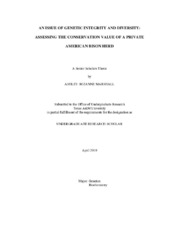| dc.description.abstract | There are 600,000 American bison (Bison bison) that exist today, all of which can be
traced to the less than 500 bison that were present after a severe bottleneck in the late
1800s. To save the species from extinction and increase the robustness of domestic
cattle (Bos taurus), ranchers interbred the two species, creating a hybrid animal. The
genetic introgression caused by this hybridization can still be seen in the current bison
population. Only two bison herds evaluated to date have shown no domestic cattle
genetic introgression: Yellowstone National Park (YNP) and Wind Cave National Park
(WC). As such, these herds are very important to the conservation of the bison species.
A private herd that was reportedly derived from YNP has shown no introgression during
initial testing. Using microsatellites randomly dispersed throughout the genome, the
genetic integrity of this herd is evaluated. It was found that this herd has an average
number of alleles per loci, but that the unbiased heterozygosity values are low when
compared to 11 known Department of Interior (DOI) herds. The low heterozygosity values could be due to a biased sex ratio that is present in the herd. This biased sex ratio
would produce inbreeding within the herd, resulting in the low unbiased heterozygosity
values. The presence of an average number of alleles per loci suggests that the low
heterozygosity value is reversible by removing this biased sex ratio. The relationship of
this herd to the reported foundation herd, YNP, is also evaluated. Though this herd is
reportedly founded from YNP only, genetic analysis shows this to be untrue. The
presence of alleles that are unique to the private herd when compared to YNP supports
this claim. A Structure analysis comparing the germplasm of the 11 DOI herds to this
private herd shows that the private herd was not founded solely from YNP, shown by the
fact that the private herd did not cluster with YNP in this analysis. This information is
important for the management of this herd and the overall conservation of the
germplasm of this species. | en |


